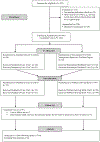Pump It Up! A randomized clinical trial to optimize insulin pump self-management behaviors in adolescents with type 1 diabetes
- PMID: 33440262
- PMCID: PMC8341128
- DOI: 10.1016/j.cct.2021.106279
Pump It Up! A randomized clinical trial to optimize insulin pump self-management behaviors in adolescents with type 1 diabetes
Abstract
Individuals with type 1 diabetes (T1D) must engage in a variety of complex and burdensome self-management behaviors daily to maintain near normal blood glucose levels and prevent complications. There is a need for interventions to improve use of sophisticated diabetes technologies, such as insulin pumps, during adolescence - a very high-risk developmental period for individuals with T1D. All diabetes devices, including insulin pumps, store large amounts of behavioral data that can be downloaded and analyzed to evaluate adherence to recommended T1D self-management behaviors. The overall objective of the present study, Pump it Up!, was to use objectively downloaded insulin pump data to inform and test two interventions to optimize insulin pump use in adolescents with T1D and their caregivers. Multiphase Optimization Strategy (MOST) was used to achieve the overall goal of this study - to separately test the main effect of the Pump It Up! Personalized T1D Self-Management Behaviors Feedback Report and the main effect of Pump It Up! Problem-Solving Skills intervention to improve T1D self-management behaviors using a 2 × 2 factorial design. The purpose of this paper is to describe the Pump It Up! study design and rationale, and participant baseline characteristics. Longitudinal data analyses will be conducted, and moderating effects of psychosocial factors will be examined in relation to primary (insulin pump self-management behaviors) and secondary (A1C) outcomes.
Copyright © 2021 Elsevier Inc. All rights reserved.
Conflict of interest statement
Declaration of Competing Interest
The authors have indicated that they have no potential conflicts of interest to disclose.
References
-
- Driscoll KA, Young-Hyman D, Use of technology when assessing adherence to diabetes self-management behaviors, Curr. Diab. Rep 14 (9) (2014) 521. - PubMed
-
- Guilfoyle SM, Crimmins NA, Hood KK, Blood glucose monitoring and glycemic control in adolescents with type 1 diabetes: meter downloads versus self-report, Pediatr. Diabetes 12 (566) (2011) 560–566. - PubMed
Publication types
MeSH terms
Substances
Grants and funding
LinkOut - more resources
Full Text Sources
Other Literature Sources
Medical


